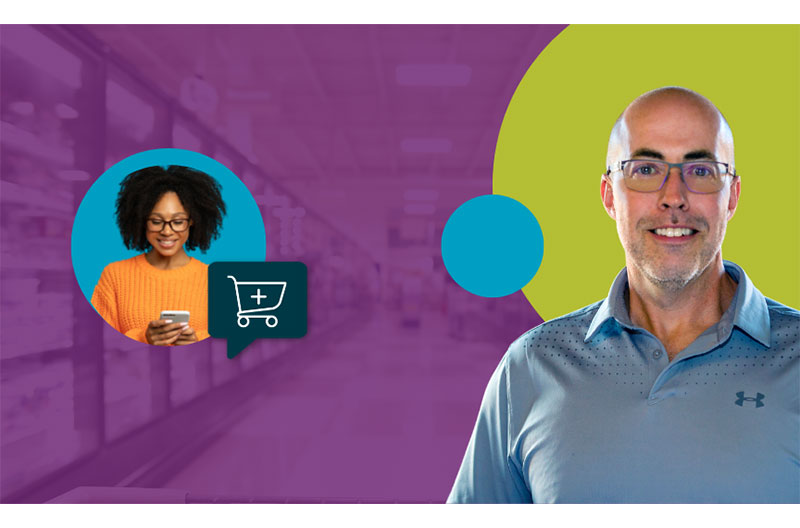Executive: Company’s approach ‘really is a focus on customer service and support’
Research from Mercatus, a provider of digital commerce solutions for grocery retail, has shown that interest in online shopping has declined since the height of COVID-19, although it’s still higher than pre-pandemic levels.
Conversely, December saw the second highest monthly total for online grocery sales since that time, according to Mark Fairhurst, VP of marketing for the Toronto-based company. About 72.2 million households, or 55 percent, bought groceries online and received them via ship-to-home, delivery or pickup. That was up 4.3 percent from December 2021.
“There have been a number of factors that have been influencing the amount of purchases happening on a monthly basis,” Fairhurst explained. “We know there was a time [when there was] concern about medical variants. And that would drive people to continue to purchase online.
“It became more about issues around inflation and customers wanting to find the best deals. And you had a commensurate increase in in-store foot traffic, but you had that learned behavior during the pandemic of buying online.”
He said the learned behavior comes from the reasons why customers continue to buy online. “It’s purely because convenience for them has been redefined.”
Convenience looks different for customers and grocers depending on the size and the retailer. Fairhurst gave the example of Walmart and Target as two retailers who rely on pickup as the main e-commerce platform, while smaller retailers continue to partner with third-party delivery services such as Instacart to provide pickup.
“A lot of regional grocers didn’t have concrete strategies to address those issues. They were either asked by their ownership or by their boards to come up with a plan,” Fairhurst said. “I think the path of least resistance was to outsource their e-commerce…since then, there’s been increasing competition, especially from the marketplace providers.”
That initial spur of e-commerce solutions has since subsided. And those quick-to-market contracts are coming to a close. Those contracts, Fairhurst said, came with “really high commission rates.” They also included monthly appeasement fees, which occur when customers find something wrong and expect refunds.
“The retailer is expected to absorb those costs. Regional grocers saw a lot of money going out there,” he said. “They’re getting a lot of money through that channel, but there’s a lot of money that was going out.”
Retailers that had to adapt to e-commerce offerings are seeing the downside to a third-party platform. Going forward, Fairhurst said he expects retailers to “own the experience themselves.” The amount of interest in e-commerce from customers has not waned, so retailers need to find a way to bring that market share into their business model. As Fairhurst noted, “We know customers prefer pickup over delivery, because it’s lower costs. They have more control over the experience.”
Mercatus research shows there still is a portion of the population that would continue to use delivery services, mostly the elderly. But more shoppers between ages 30 and 45 prefer pickup or other first-party e-commerce services, such as fuel points and rewards programs.
While Mercatus may not have all the answers, Fairhurst recommended retailers monitor customers and their spending habits.
“I think it’s a lot of experimentation and testing that needs to happen,” he said. “I think at the independent level, it’s really knowing your customers, understanding what is driving their purchase behavior. I think there’s no getting around that, and then cater to their needs. You’ll make the right decision by providing a multitude of services.”
That’s where Mercatus comes in. The e-commerce company develops and implements a full “end-to-end grocery e-commerce experience.”
“Our platform is scalable enough to handle the needs of big chains and small ones,” Fairhurst said. “The unique thing about it is we have what we call a single code base.
“If you’re a Weis Markets or a Stater Brothers…you’re driving a lot of unique technology integrations. They can cater to their customers at large. The same innovation that is available to those grocery retailers is also available through our platform.”
This is what Fairhurst described as “white glove service.” The platform aims to take the same information used by larger retailers and make it available to smaller ones. “It really is a focus on customer service and support.”
The platform provides “everything from strategy to implementation and post-customer follow up.” It makes the retailer available on any platform, whether that be computer or mobile based.
“We have enabled components like loyalty and digital couponing,” Fairhurst said. “We’ve enabled SNAP EBT for our clients…we’ve also enabled what we call white label fulfillment.”
Mercatus’ white label fulfillment can help retailers manage inventory for pickup capabilities and third-party delivery. “We’re basically flattening the playing field and giving independents the opportunity to compete with retail chains much larger than they are,” Fairhurst explained.
In the vein of driving innovation, Mercatus recently released Mercatus Mobile, the newest iteration of its mobile app. Within the past year, about 5 percent more e-commerce transactions are happening on a grocer’s mobile app.
According to Fairhurst, what makes the app so enticing is its architecture. The underlying code that runs it is the same type used by large companies, such as Meta, Shopify and Walmart. The architecture will help Mercatus adapt to the marketplace as e-commerce continues to grow and shift.
“Again, it goes back to leveling that playing field. It’s going to help us develop faster and innovate faster because it’s a more modern architecture. It allows retailers to offer that modern experience,” Fairhurst said.

